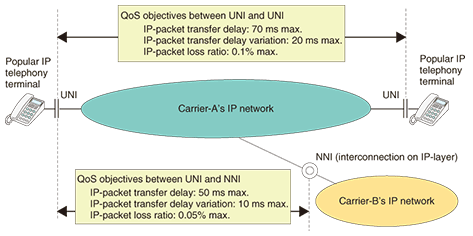 |
|||||||||||
|
|
|||||||||||
|
Special Feature: NGN Focus Vol. 7, No. 7, pp. 1–3, July 2009. https://doi.org/10.53829/ntr200907sf1 Quality Standards and Quality Control in the NGNAbstractThis article introduces two key technologies that are characteristic of the Next Generation Network (NGN): priority classes and quality control. These enable communications with guaranteed quality of service (QoS) unlike the best-effort communications provided by existing Internet protocol (IP) networks.
1. QoS in the NGNQuality is an important concept in the Next Generation Network (NGN), but the word quality itself has a wide variety of meanings. In the context of communication services, it may be used to describe whether the voice of the other party in a telephone call can be clearly heard, whether communication equipment is operating normally, or whether a customer is treated well when applying for a service. Some examples of quality in communication services, called quality of service (QoS), are shown in Fig. 1. Amongst these various meanings of quality, the main focus in the NGN is on quality in the IP (Internet protocol) layer.
2. Priority classes and transport quality guaranteeStandards to be applied to communication quality in the NGN are now being discussed and debated at ITU-T (International Telecommunication Union, Telecommunication Standardization Sector) and other international standardization bodies [1], [2]. NTT provides multiple priority classes while referring to those standardization trends. A priority class relates to transport quality on the network. A particular priority class is chosen with the aim of guaranteeing the transport quality required by the type of communication in question; e.g., a voice call or videophone needs strict realtime operation while one-way video delivery does not require such stringent realtime characteristics. The use of such priority classes in combination with the quality control technology described below enables the development of QoS-type services that can provide a stable level of quality during communications. There is no such mechanism in existing IP networks, which can provide only a best-effort class in which quality cannot be guaranteed at all. The NGN supports the use of both priority classes and the best-effort class, enabling the simultaneous provision on the same network of services having different operating requirements. 3. Quality control technologyThe mechanism for guaranteeing quality in each priority class is quality control technology and it runs on a session control server at the time of a communications request or during communications. This QoS control mechanism is shown in Fig. 2. First, at the time of a communications request, the terminal communicates with the session control server, which first determines whether or not it is possible to provide the QoS for the priority class desired by the terminal. If it is, the server notifies the terminal to begin communications. On the other hand, if it is not, the server rejects the communication request. Once a communications request has been accepted and communications has begun, transport equipment within the network uses information received from the session control server to check whether network traffic for each communication session is compliant. Any traffic packets deemed to be noncompliant are discarded. This is a necessary function to prevent adverse effects not only on the QoS of the communication session in which those noncompliant packets were found but also on the QoS of other communication sessions. This function for securing or maintaining the QoS of each communication session at the time of a communications request or during communications, which is a complete contrast to the best-effort class, makes it possible to ensure the communications quality for all priority classes.
4. IP-telephony QoS regulations and QoS allocationAmong the various services provided by the NGN, IP telephony using 0AB–J numbers in Japan must conform to QoS regulations that are legally prescribed [3]. These QoS regulations include new standards for network quality in addition to those pertaining to conventional voice telephone calls using 0AB–J numbers. They reflect discussions held at the Next Generation IP Network Promotion Forum [4] and elsewhere, and they were legally prescribed by a Japanese ordinance revision on April 1, 2008. QoS objectives are prescribed by IP-packet transfer delay, transfer delay variation, and loss ratio in network segments such as among user-to-network interfaces (UNIs) or between a UNI and a network-to-network interface (NNI) in the case of an inter-carrier connection. QoS regulations for IP telephony are shown in Fig. 3. At NTT, priority classes provided by the NGN are used as a means of maintaining the prescribed QoS objectives.
5. Concluding remarksThe role of QoS-related technology is becoming increasingly important as the lineup of services that use priority classes expands. Moreover, quality- and traffic-related technologies give the NGN advantages over other networks. We plan to increase our efforts to develop quality-related technology as platform technology supporting the NGN and to promote NGN quality standardization activities. Such platform technology will also contribute to the expansion of NTT Group business. References
|
|||||||||||











